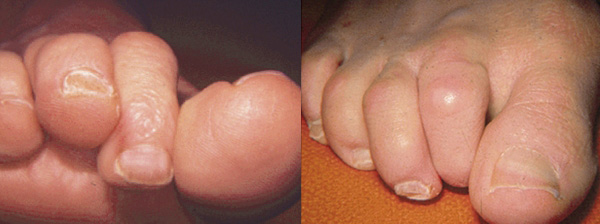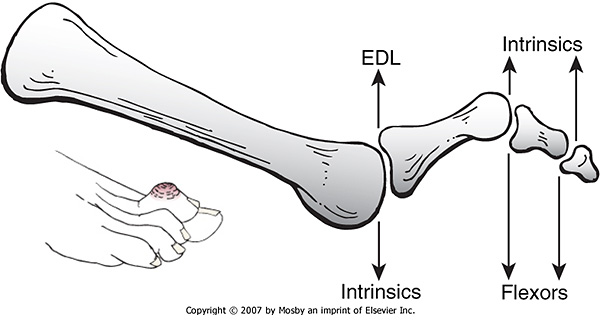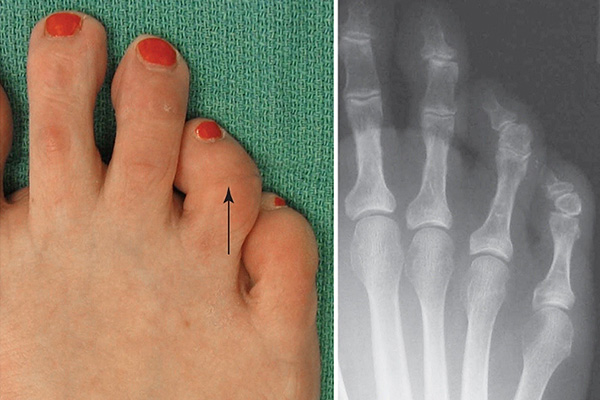A deformed toe is one of the most common conditions known to affect the foot, whether it is a hammertoe, mallet toe, or rotated 4th or 5th toe. The deformity can be flexible or rigid. It can also increase with weight-bearing. Often toe deformities become painful with shoe gear (especially closed toe shoes) and activity. Shoe selection can be difficult for individuals suffering from these conditions.

Hammertoe is a typical toe deformity.
Hammertoe
Hammertoe is a flexible or rigid contraction usually affecting the second, third, fourth, or fifth toes. Most often it is caused by biomechanical abnormality causing larger muscles of the foot and leg to overpower the smaller intrinsic muscles of the foot. This muscle imbalance leads to a bending or “buckling” of the toe joints. These buckled or contracted positions cause pain in numerous areas of the toes from the tip of the toe, top of the toe, to the joint at the ball of the foot. Boney prominences may occur on top of the toe. Tendons, ligaments, and joint capsules in this area have a greater chance of tightening and shortening. Shoe irritation of the deformed digit results in painful corns, skin inflammation, and inability to wear shoes comfortably. If left untreated, these conditions can progress to ulcers or infections.

Hammertoe is caused by imbalance between intrinsic and extrinsic muscle of the foot.
Mallet Toe
A mallet toe is similar to a hammertoe except the joint that is affected is closer to the end of the toe. Much like hammertoes, the deformity can be flexible or rigid. The cause of mallet toe is also due to muscle imbalance or instability within the intrinsic musculature of the foot, causing the toes to buckle. Typically, mallet toe results in painful corn or callus at the tip of the toe. It can also cause excessive friction on top of the toe with shoe gear making activity and shoe gear selection difficult.

Mallet Toe.
Adductor Varus Deformity 4th or 5th Toe
This deformity occurs when either 4th and/or 5th toe is rotated. This often results in painful callus on the side of the 5th toe that rubs against closed-toe shoes. At times, painful corns can occur in between the two toes or on the tips of the toes. Again, this deformity occurs because of overpowering larger muscles/tendons within the foot due to faulty biomechanics. The tendons attached to the bottom of 4th and 5th toes pull at an oblique angle, thus overpowering of these tendons can cause the toe to become rotated over time.

Adducto Varus Deformity.
Conservative Treatment Options
Conservative treatment consists of one or more of the following:
- Proper shoe gear selection to ensure enough room in the toe box to accommodate for the toe contractures.
- Routine trimming of the painful corns.
- Custom or over-the-counter orthotics to control instability of the foot due to faulty mechanics and therefore prevent progression or worsening of the deformity.
Surgical Options
If the above conservative methods fail to reduce pain, corrective toe surgery should be considered. Dr. Wang specializes in treating foot deformities. She will conduct a thorough examination to determine if surgery is indicated and which procedure is most suitable based on the patient’s condition. The doctor will also order X-rays for surgical planning. In most cases, surgical correction can be performed under local anesthesia and patient is able to weight-bearing following the surgery. Please visit our Hammertoe Surgery page for more information on surgical treatment.
Foot pain is not normal. It should not prevent you from performing activities of daily living or things that you enjoy. If you suffer from toe deformities such as hammertoe or mallet toe, let our doctor who has knowledgeable experience in both conservative as well as surgical treatments help you. Contact us today for a consultation with our foot specialist.

